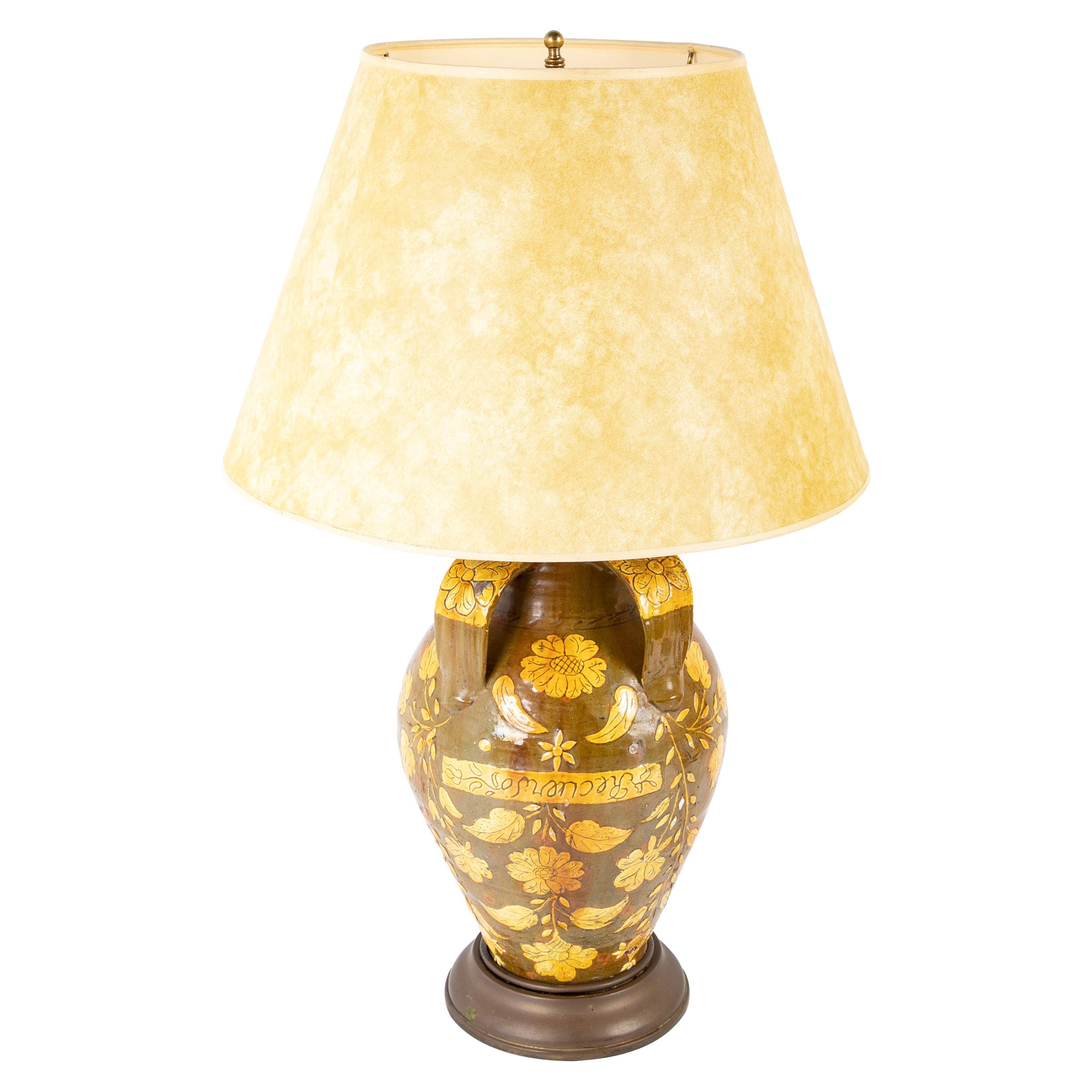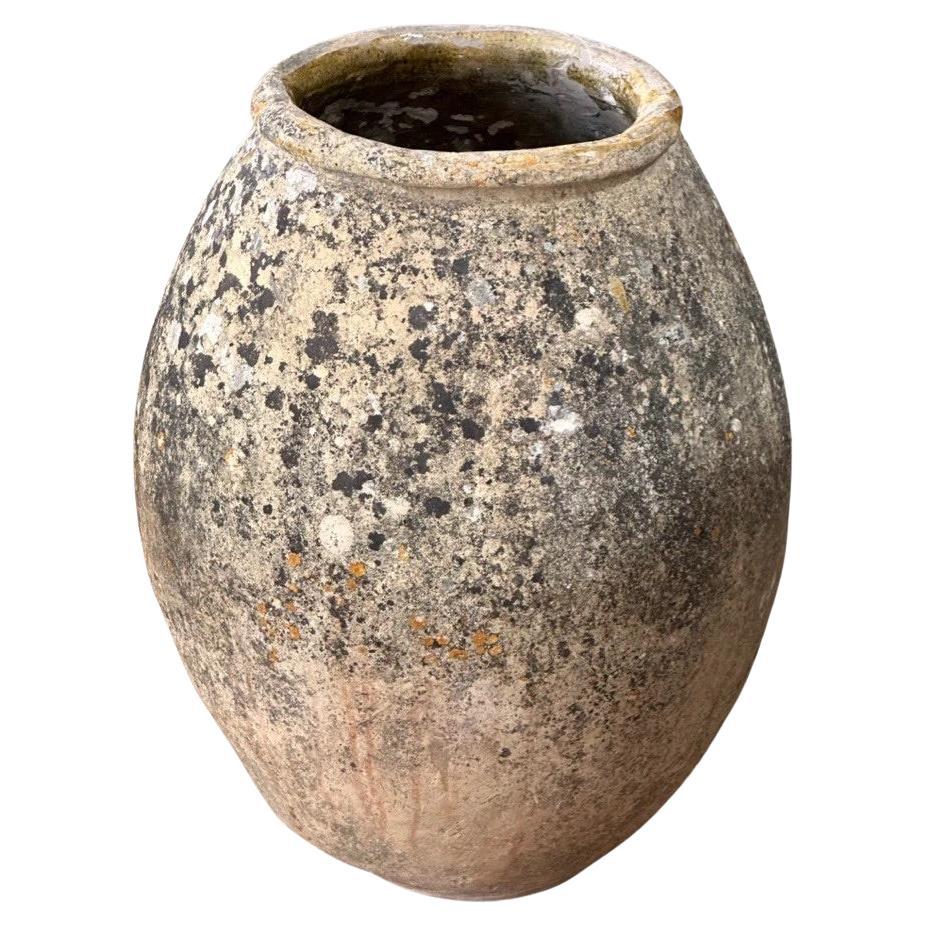Items Similar to Ceramic Drug Jar or Syrup Jar, Possibly Italy, 18th Century
Want more images or videos?
Request additional images or videos from the seller
1 of 8
Ceramic Drug Jar or Syrup Jar, Possibly Italy, 18th Century
About the Item
The decoration of ceramics in blue tones on a white background was common in Europe as far back as the 17th century (Dutch and English pieces, works in Talavera de la Reina in Spain, etc.). In the Italian case and in ceramics (with this origin, usually called "maiólica"), it is already decorated in cobalt blue on white in works of Byzantine inspiration in the Quattrocento, accompanying varied influences. In the first third of the 16th century this decoration "porcelain" (since, apparently, is inspired distantly in Chinese porcelain works that use these colors) continues, with touches of other colors. Compare the present work with the pieces known as "Porcelana de los Médici", from the third quarter of the 16th century. It is called "berrettina" to the glazed Majolica from light blue to dark blue, obtained with cobalt oxide. It was used from the 16th century to the first half of the seventeenth, in productions mainly of Liguria and Veneto. Likewise, it is worth mentioning a series of pieces with which this one has something more related: pharmacy bottle with San Pablo (made in Savona in the 17th century, now in the International Ceramics Museum of Faenza), or with preserved almonds the Museum of the Hispanic Pharmacy of the Complutense University of Madrid, works of the Italian region of Savona, pieces in private collections, etc."
Size: 24 x 30 x 26 cms.
- Dimensions:Height: 10.24 in (26 cm)Width: 9.45 in (24 cm)Depth: 11.82 in (30 cm)
- Style:Neoclassical (Of the Period)
- Materials and Techniques:
- Place of Origin:
- Period:
- Date of Manufacture:18th Century
- Condition:Wear consistent with age and use. Minor losses. Minor fading.
- Seller Location:Madrid, ES
- Reference Number:
About the Seller
4.9
Vetted Seller
These experienced sellers undergo a comprehensive evaluation by our team of in-house experts.
Established in 1985
1stDibs seller since 2017
292 sales on 1stDibs
Typical response time: 16 hours
- ShippingRetrieving quote...Ships From: Madrid, Spain
- Return PolicyThis item cannot be returned.
More From This SellerView All
- Villafeliche Jug, Aragon, Spain, 18th CenturyLocated in Madrid, ESLate Baroque pottery jug made and decorated with high temperature glazes over a white slip of tin. These motifs are combined with enameled decorations in relief obtained mold. The typology of the piece combines Italian jug with handle ovoid belly and vertical bow, with the peak jug typically Spanish, characterized by the outgoing peak of the mouth. Decorations reveal the oriental influence, with large floral bouquets arranged asymmetrically and complex landscapes with architecture and palm trees, which remove some figures, such as totally Western. The reasons appear pincelados in manganese black, and colored with ocher, blue, green and red, mainly enamels. Aragon ceramic least a century old will be characterized by a strong own, combined with the influences of personality Talavera and Catalonia. You will have three main centers: Teruel, Muel and Villafeliche, the first two with tradition since the 16th century, and the third created in the late 17th century. The Villafeliche will generally be very popular ceramics...Category
Antique 18th Century Spanish Neoclassical Ceramics
MaterialsCeramic
- Silver Cup with Property Inscription. Possibly Spanish American, 18th CenturyLocated in Madrid, ESTembladera or bernegal with property inscription. Possibly Spanish American, 18th century. Silver trembling dish in its color with a wide and circular base and a mouth of greater diameter than this, body with a fine line engraved towards the edge and an inscription of ownership on the front (Lucas Vilacha) made with small dots. It also has two handles decorated with vegetal and grotesque elements with human heads, with shapes similar to lions or dogs visible at the top. In Spanish silverware...Category
Antique 18th Century South American Neoclassical Sterling Silver
MaterialsSilver
- Silver Incense Boat 'naviculae', Possibly Portugal, 18th CenturyLocated in Madrid, ESNaveta. Silver. Possibly Portugal, 18th century. Base with counterweight. With hallmarks. Naveta with oval foot decorated with relief elements and moldings, balustrade foot and body with light boat shape, presenting a hinged lid in the front, a widening in the lower area towards the foot and a decoration distributed throughout the exterior base of rockery motifs and plant elements (the same theme is presented on the foot and base) on a background of chopped luster, with an angel's head on two wings in relief towards the peak, accompanied by plant elements (the which protrude from the edge of the lid). Although the shape of the piece follows in general lines the most usual prototypes in these incense containers used in the liturgy, it is necessary to indicate that it was more frequent to find them more similar to a ship. The naveta's belonging to the influence of Rococo is clear both for the lines of the object and for the decoration to which reference has already been made (pebbles, plant elements with movement, volutes with pronounced curves, contrasts between concave and convex lines ... ), as well as it is possible to find some points in common with Portuguese works (presents an auction with an angel head in relief a silver naveta with a spoon by Leandro Gagliardi made in Rome between 1744 and 1750 that is preserved in the Museum of Sao Roque of Lisbon in Portugal, compare with the silver plated censer that the same master made between 1749 and 1751 for the Chapel of San Juan Bautista of the Church of San Roque in Lisbon). The contrast marks present in the upper part of the naveta (the "capitalized" letters in a rectangular space), although it should also be noted that this work does not follow the most striking typology of navetas related to this center (naveta de 18th century silver from the Church of Alcántara de Maranhao, Brazil; naveta by Sebastiao Bernardes dos Santos, dated 1747 from Sé do Funchal, which is kept in the Museu de Arte Sacra Do Funchal in Madeira Portugal...Category
Antique 18th Century European Rococo Religious Items
MaterialsSilver, Other
- Silver Jar or Jug, De San Faurí, Juan, Spain, Madrid, 18th CenturyBy Spanish ManufactoryLocated in Madrid, ESJug or jug. Silver. DE SAN FAURÍ, Juan (1745-1785). Spain, Madrid, towards the last third of the 18th century. With contrast and burilada marks, and property name (Ochoa). The jug has an oval base with slight curves and a body divided into two areas (wider in the lower half, slightly concave in the upper half) with a series of curved “gajos”; the peak shows simple architectural decoration and smooth areas; the handle is of a type known as brace, with classicist architectural elements; the lid follows the lines of the body and is finished off with a vegetable shape creating a knob. On one of the sides, towards the foot, there is the engraved text "Ochoa", referring to a former owner. Contrasting marks place the creation of the piece in Madrid. Another one that appears could be one of those used by the silversmith Juan de San Faurí. With Felipe V, numerous French influences, along with some Italian ones, came to silverware, both from the hand of craftsmen of these origins and from pieces. Little marking continues in the works, except in important centers such as Madrid, and civil typologies acquired great importance. As in the rest of the country, the Baroque, Rococo and Neoclassical tendencies coexisted at the Court, although, being the center that set the standard for the rest, the former soon departed, introducing Rococo before 1740 or on that date, and Neoclassicism around 1770 (gradually imposing itself from 1780). The jug follows the most common prototype since the arrival of the Bourbons, characterized by its European influence and the great difference it shows with the type known as the “spout jug”. Compare with the Francisco García...Category
Antique Late 18th Century Spanish Neoclassical Serving Pieces
MaterialsSilver
- Centerpiece, Ceramic, Possibly Lunéville, France, 19th CenturyBy LunevilleLocated in Madrid, ESWith marks. Centerpiece circular base and oval body decorated to the interior with small bouquets of flowers and the outside with an elaborate composition based on architectural and...Category
Antique 19th Century European Neoclassical Centerpieces
MaterialsCeramic
- Silver Ceremony Cup or Vase, Spain, 18th CenturyLocated in Madrid, ESBernegal or trembling with handles. Silver. Spain, 18th century. Avocado shaker in its color with a circular base, without base or foot, and a hemispherical body that is wider at the top, which has two handles on the sides. These present two facing C's of different sizes (the largest on top) or in the shape of that, and a decoration based on silver pearls and a bird perched on the upper part (both of the piece located facing the center). In Spanish silverware...Category
Antique 18th Century Spanish Neoclassical Decorative Bowls
MaterialsSilver
You May Also Like
- 18th Century, Dutch Delft Drug Jar Rose SmellBy AK Dutch DelftwareLocated in Newark, EnglandFine dutch delft 18th century drug jar. The jar of ovoid form with rolled top rim and tapered body down to the circular flat foot rim, decorated with opposing...Category
Antique 18th Century Dutch Baroque Jars
MaterialsCeramic
- 18th Century Indigo Blue Glazed Ceramic JarLocated in Marbella, ES18th century Indigo blue glazed ceramic jar.Category
Antique 18th Century Spanish Scientific Instruments
MaterialsCeramic
- Delft Ceramic Drug Jar, circa 1800Located in Arundel, GBDelft Drug Jar with Cover. Pretty Blue and White Design. Holland, circa 1800.Category
Antique Early 19th Century Dutch Ceramics
MaterialsCeramic
- Savona Italian Tin Glazed Polychrome Painted Pottery Syrup JarLocated in Bishop's Stortford, HertfordshireAn antique Italian hand painted Savona tin glazed syrup jar inscribed AQUA DE PIANTAGNE dating from the early 18th century, the rounded earthenware jar stand...Category
Antique Early 18th Century Italian Baroque Pottery
MaterialsPottery
- 18th Century Spanish Glazed Ceramic Jar Mounted as a Table LampLocated in Stamford, CTVery interesting 18th century Spanish ceramic wine or oil storage jar with wonderful olive green glaze with raised leaf and floral design ...Category
Antique Mid-18th Century Spanish Baroque Table Lamps
MaterialsCeramic, Pottery
- Rare French 18th Century Biot JarLocated in Charlottesville, VAFine, rare 18th Century French biot jar, having fabulous patination and lichen. Found in Provence.Category
Antique 18th Century French Ceramics
MaterialsCeramic
Recently Viewed
View AllMore Ways To Browse
18th Century Ceramics
Italian Silver 18th Century
18th Century English Silver
18th Century English Glass
18th Century English Ceramics
18th Century English Ceramics
18th Century Chinese Glass
Antique Silver Jar
English China And Ceramics
Compare Silver
18th Century English Porcelain
Cobalt 18th Century
English 16th Century Furniture
Blue Glass Jars
Blue Glass Jar
Antique Italian Ceramic
Blue And White Italian Ceramics
17th And 18th Century English Furniture





